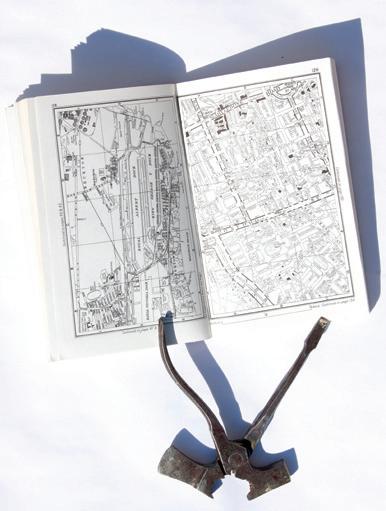
3 minute read
calls for articles
on site review 39: tools
A summer issue: a collection of the most beautiful, most useful or the most ingenious tools that you have actually used.
Advertisement
What is a tool? A device that aids in some task: a hammer hammers in a nail, as does a rock. Or, at the end of some other axis, a book is a tool that unlocks a world. Is a tape measure a tool? yes. Is a brush? a telescope? Josh Silver’s adjustable glasses? absolutely. Is this a tool from Home Hardware, or is this Seamus Heaney’s father’s spade? There is quite a bit of latitude here.
And beauty is not an aesthetic qualification in this — beauty is very much in the eye and hand of the beholder: the knife in the box you always use, the pen that fits your hand, the notebook that fits your pocket. There is something in the perfect fit that defines the relationship between body, task and the intermediary.
Lots of different kinds of things work for us, please send a photograph of the object itself, and/or the object in use. Support text minimal, much as in the summer drawing issue of 2020. We really just want to look at things.
Think about the page, 9 x 13” and how you might fill it: what do you want us to see and know about this object?
Ideas please by March 1, 2021 Use our contact link: www.onsitereview.ca/contact-us
Final submission materials due June 1, 2021
Remember, we are a journal about architecture, landscape, infrastructure, urban design, all as conducted materially on site.
on site review 40: the architect’s library
We would like to ask you, as an architect, designer, landscape architect, urbanist or engineer, what your relationship is to books in general and your books in particular.
Is it passive or active? Do you still use your books, or do you circumvent them with wikipedia and downloads? Where are your books? on shelves? in boxes? all over the floor? What is the material world of your books — the shelves, the bookcases, the room(s) in which they live? Do you buy books, or do you consider the library as the site of your books?
If books have played a role in your development and your continued practice, we would like to hear about it.
On Site review 40: the architect’s library will be a perpetual work in progress, laid out and published as pieces come in. It will also work in conjunction with Architecture & Reading in Crisis, a project of city | speculations. https://www.cityspeculations.com/
To get you thinking, here are two essays about books, reading, place and time: first, a beautiful essay, recommended by Ella Chmielewska, is ‘The Drowned Library (Reflections on Found, Lost, and Translated Books and Languages)’ by Anton Shammas. There is a free download here: https://levantinejournal.org/product/drowned-library-reflections-found-lost-translatedbooks-languages/ The second is Nicole Raziya Fong’s ‘On the Alchemy of Fields’, in The Capilano Review, Fall 2020. https://thecapilanoreview.com/nicole-raziyafong-on-the-alchemy-of-fields
Neither of these are by architects or designers, but they talk about books as material objects, as magical stories, as things that slip forwards and back in translation: not just linguistic, but translation between phases of a life, between studies, between changes of profession, country, states of being. They move the personal from something inwardly looking and private, to something that reaches outward.
We can all write about such things because we all have a life, a past, and a present —sometimes not too clear until you start to write it down and then patterns form, memories surface. So go to it! Let’s hear about the architect’s library.
specifications:
word count: aim for 2000 words
images: as ultimately this will go to print, images should be sent as 300dpi jpgs, with full photo credits and permission to publish for any images not your own.
to send your proposal, any time, use our contact link: www.onsitereview.ca/contact-us
This call for articles will run for a year, submissions will be added to the online publication as they come in. If you need a hard deadline for proposals, make it May 1, 2021. Earlier is better though, as it gives you more time to write your article / essay / photo-essay, or to make your video, or to design a library.


